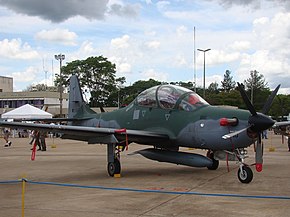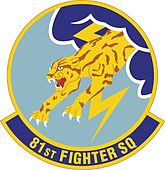81st Fighter Squadron
| 81st Fighter Squadron | |
|---|---|

Embraer A-29 Super Tucano
|
|
| Active | 1942–1945; 1947–1951; 1953–2013; 2014-present |
| Country | United States |
| Branch | United States Air Force |
| Type | Fighter training |
| Part of |
Air Education and Training Command Nineteenth Air Force 14th Flying Training Wing 14th Operations Group |
| Garrison/HQ | Moody Air Force Base |
| Nickname(s) | Panthers |
| Engagements | Battle of Normandy |
| Decorations |
Distinguished Unit Citation Air Force Outstanding Unit Award with Combat V device |
| Insignia | |
| 81st Fighter Squadron emblem (Approved 3 July 1967, revised 12 April 2007) |  |
The 81st Fighter Squadron (81 FS) is a flying squadron of the United States Air Force. It is part of the 23rd Wing at Moody Air Force Base, Georgia, and operates the A-29 Super Tucano aircraft conducting close air support training to the Afghan Air Force as part of ISAF.
Provide the Supreme Headquarters Allied Powers Europe and United States Air Forces in Europe commanders with dedicated close air support, air strike control, and combat search and rescue capability.
The squadron was first activated on 15 January 1942, at Key Field, Mississippi, as the 81st Pursuit Squadron flying the P-40 Warhawk. The squadron was assigned to the 50th Fighter Group to replace the 11th Pursuit Squadron, which had been transferred after the Japanese attack on Pearl Harbor to reinforce the air defenses of Alaska. In May 1942 the 50th Group was assigned to the Fighter Command School of the Army Air Forces School of Applied Tactics and the 81st became the 81st Fighter Squadron (Special).
Night fighter combat over the skies of England made the Army Air Forces aware of the need for night air defense training and tactics development. The Air Defense Operational Training Unit had been established on 26 March. Later it was renamed the Fighter Command School. The 81st Fighter Squadron became responsible for night fighter training, using Douglas P-70 Havocs. The 81st was assigned the "daunting task" of training sufficient crews to man seventeen night fighter squadrons within twelve months, initially " [w]ith no trained instructor pilots or [radar operator]s, no aircraft, no radar, and no communications equipment" The original night fighter crews were recruited from 27 pilots from the 50th Group who were qualified to fly twin-engine aircraft. They attended transition training school at Williams Field, Arizona before returning to Florida.
...
Wikipedia
